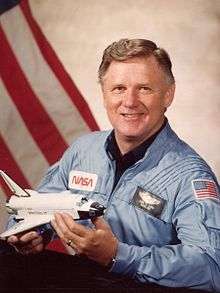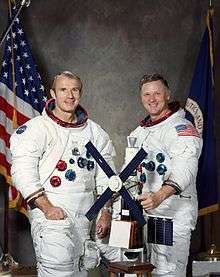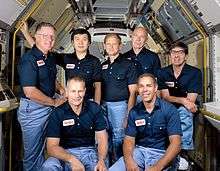Don L. Lind
Don Leslie Lind (born May 18, 1930), (Cmdr, USNR, Ret.), is an American scientist and a former naval officer and aviator, and NASA astronaut. He graduated from the University of Utah with an undergraduate degree in physics in 1953. Following his military service obligation, he earned a Ph.D. in high-energy nuclear physics from the University of California, Berkeley in 1964.
Don L. Lind | |
|---|---|
 | |
| Born | May 18, 1930 Midvale, Utah, U.S. |
| Status | Retired |
| Nationality | American |
| Other names | Don Leslie Lind |
| Alma mater | University of Utah, B.S. 1953 UC Berkeley, Ph.D. 1964 University of Alaska Fairbanks |
| Occupation | Naval aviator, scientist |
| Space career | |
| NASA Astronaut | |
| Rank | |
Time in space | 7d 00h 08m |
| Selection | 1966 NASA Group 5 |
| Missions | STS-51-B |
Mission insignia | |
| Retirement | April 1986 |
Lind was a Naval Aviator and attained the rank of Commander in the United States Naval Reserve. After completing his doctorate, Lind worked at NASA's Goddard Research Center from 1964 to 1966. Selected with Astronaut Group 5 in 1966, he helped to develop the Apollo 11 EVA activities, and served as CAPCOM for the Apollo 11 and Apollo 12 missions. Lind was then assigned as backup Pilot for Skylab 3 and Skylab 4 and nearly flew on the proposed Skylab Rescue mission.
Lind was the Payload Commander on his only flight, STS-51-B, launched April 29, 1985. He designed an experiment to capture the Earth's aurora. The payload experiments consisted primarily of microgravity research and atmospheric measurement. The Orbiter Challenger completed 110 orbits before landing at Edwards Air Force Base, California.
Biography
Early life and education
Lind was born May 18, 1930, and raised in Midvale, Utah, with his two sisters, Charlene and Kathleen. He attended Midvale Elementary School and graduated from Jordan High School in 1948. He was an Eagle Scout with the Boy Scouts of America, its highest rank.[1] He received a Bachelor of Science degree with high honors in physics from the University of Utah in 1953.[2]
As a Naval Aviator, Lind volunteered to take high-altitude photo emulsions of cosmic rays for the University of California, Berkeley during flights. This helped him enroll at Berkeley,[3][4] where Lind researched pion-nucleon scattering in the Lawrence Radiation Laboratory and earned a Ph.D. in high-energy nuclear physics in 1964.[2] During a leave of absence from NASA, he conducted postdoctoral research at the University of Alaska Fairbanks' Geophysical Institute from 1975 to 1976.[5]
Navy service
Lind enrolled at the United States Navy Officer Candidate School at Newport, Rhode Island after completing his undergraduate education. Although he jokingly requested flight training, he was unable to change his assignment and found that he enjoyed flying.[6] He received his Wings of Gold in 1955 at NAS Corpus Christi, Texas, and served four years on active duty with the Navy at San Diego and later aboard the carrier USS Hancock. He ultimately logged more than 4,500 hours of flight time during his naval and NASA careers, 4,000 of which were in jet aircraft.[2] Lind continued to serve in the United States Naval Reserve after completing his service obligation before resigning at the rank of Commander in 1969.[7]
NASA career
Pre-astronaut and selection

From 1964 to 1966, Lind worked at the NASA Goddard Space Flight Center as a space physicist.[3] He was involved in experiments to determine the nature and properties of low-energy particles within the Earth's magnetosphere and interplanetary space. Lind applied for NASA's third group of astronauts but did not have enough flight hours, and was too old for the fourth group.[5] After the age restriction changed, he was among the fifth group, the "Original Nineteen," selected in April 1966.[4][8]
Although the "Original Nineteen" was an all-pilot cohort (in contrast to the fourth and sixth groups, which were limited to medical doctors and Ph.D. scientists), Lind and Group 5 colleague Bruce McCandless II were "effectively treated... as scientist-astronauts" by NASA due to their academic training and mutual lack of the test pilot experience highly privileged by Deke Slayton, Al Shepard and other NASA managers at the time; among other factors, this would delay their progression in the flight rotation.[5][9]
Apollo
Along with geologist-astronaut Harrison Schmitt, Lind helped to develop and demonstrate the flight plan for the Apollo 11 EVA (including the Apollo Lunar Surface Experiments Packages that would continue to relay data following the missions) and other tools used on the lunar surface.[3][10] He also served as a capsule communicator on the Apollo 11 and Apollo 12 missions. Schmitt, Owen Garriott and Lind were the only scientist-astronauts to receive advanced helicopter training, a key prerequisite for piloting the Apollo Lunar Module.[11] Due to standard crew rotations, it is believed that Lind would have followed Schmitt as the second scientist-astronaut Lunar Module Pilot on one of the canceled Apollo missions or projected long-range Apollo Applications Program lunar survey missions.[12]
Skylab
Amid the gradual cancellation of the later Apollo missions and the devolution of the AAP into Project Skylab, Lind was formally reassigned to the latter program in August 1969; according to Slayton, who noted Lind's disappointment, "with the cancellation of [Apollo] 20, I could see I just wasn't going to have a flight for him."[13] Together, Lind and Group 6 scientist-astronaut William B. Lenoir comprised the Earth Resources Group of the Skylab Branch Office.[7]
Lind, on his role as backup Pilot for Skylab 3 and 4.[5]
Lind served as backup Pilot alongside backup Commander Vance D. Brand and backup Science Pilot Lenoir for Skylab 3 and Skylab 4, the second and third manned Skylab missions; was on standby for a rescue mission planned when malfunctions developed in Skylab 3's Apollo Command/Service Module (ultimately thwarted due to Brand and Lind's resourcefulness in devising a solution in the simulators) and the proposed 20-day Skylab 5 mission (scrapped in favor of the more economical extension of Skylab 4 from 56 to 84 days); and may have flown as a Pilot or Science Pilot on Skylab B.[5][14]
According to David Shayler, Lind "could never understand why he was not on the [Skylab 4] crew as [S]cience [P]ilot" due to his work on the mission's Earth resources package; this could be attributed in part to seniority and specialization, as all of the Science Pilots were drawn from Group 4. Additionally, Skylab 4 Science Pilot Edward Gibson (like Lind, an atmospheric physicist) had taken on a research program in solar physics and worked on the Apollo Telescope Mount while Lind was still on track to be assigned to a lunar mission.[15] Although he cross-trained with Lenoir and briefly proposed swapping positions with his crewmate, he elected to retain his original assignment due to the greater likelihood of the rescue mission (which could only accommodate the Commander and Pilot) amid the space program's dwindling flight opportunities.[14]
When the Smithsonian Air and Space Museum received the unused Skylab B he "cried ceremonially in front of it", Lind later said; "I was ... in the right place at the wrong time".[16]
In 1972, Lind expressed interest in being assigned to the Apollo-Soyuz Test Project, the final mission of the Apollo program; ultimately, Brand was assigned as Command Module Pilot alongside senior managers Slayton (who effectively assigned himself to the mission as Docking Module Pilot after being medically grounded for most of the space program) and Commander Thomas P. Stafford.[17] He was reassigned to the Science and Applications Directorate in 1974, formally codifying his status as a scientist-astronaut.[7]
According to Michael Cassutt, in 1970, Lind "openly complained" to George Abbey (then technical assistant to Johnson Space Center director Robert R. Gilruth) about the perceived administrative machinations of Slayton and Shepard and Harrison Schmitt's assignment to Apollo 17.[18] However, Abbey—a close friend of Schmitt who would eventually oversee Astronaut Corps assignments as director of flight operations from 1976 to 1988—took umbrage at Lind's cooperation with a 1969 Washington Post report that exposed rampant dissatisfaction among the scientist-astronauts. He also alleged that Lind complained about "any and all subjects" related to the space program, associating him with a coterie of scientist-astronauts (including Story Musgrave) who perceived Abbey as a "faceless 'horse-holder' who had worked his way into a powerful job." Although Abbey could not forestall Lind's eventual flight, their acrimonious relationship played a key role in hindering the astronaut's progression in the flight rotation.[18]
Shuttle era

For the Space Shuttle program, Lind was reassigned as a Mission Specialist along with McCandless (who, unlike Lind, continued to train as a potential Space Shuttle orbiter pilot until 1983)[7] and the remaining Apollo-era scientist-astronauts. During this period, he was a member of the Astronaut Office's Operations Missions development group, responsible for developing payloads for the early Space Shuttle Orbital Flight Test (OFT) missions and the Canadarm.[5]
Lind finally flew as the lead Mission Specialist and de facto Payload Commander on STS-51-B (April 29 to May 6, 1985), logging over 168 hours in space. Due to Apollo-era managerial preferences, his contentious relationship with George Abbey, NASA budgetary problems and delays in the Space Shuttle program, Lind waited longer than any other continuously serving American astronaut for a spaceflight: 19 years.[4][5][19]
STS-51-B, the Spacelab-3 science mission, launched from Kennedy Space Center, Florida, on April 29, 1985. Following several delays, this was the first fully operational Spacelab mission. A space program aficionado has speculated that Lind's science-dominant assignment was a "reward... for sticking around so long," in contrast to the majority of early STS missions that were centered around routinized satellite deployments.[20] The seven men crew investigated crystal growth, drop dynamics leading to containerless material processing, atmospheric trace gas spectroscopy, solar and planetary atmospheric simulation, cosmic rays, laboratory animals and human medical monitoring.[2]
With the help of his Alaska postdoctoral group, Lind developed and conducted an experiment to photograph the Earth's aurora. As the experiment used a camera already on the Shuttle, NASA only needed to purchase three rolls of film for $36; Lind described it as "the cheapest experiment that has ever gone into space."[5] After completing 110 orbits of the Earth, the Orbiter Challenger landed at Edwards Air Force Base, California, on May 6, 1985.[2]
Lind retired from NASA on the twentieth anniversary of his selection in 1986. For nine years thereafter, he served as a professor of physics and astronomy at Utah State University, until his retirement in 1995.[4]
Awards and honors
Lind is a member of the American Geophysical Union, the American Association for the Advancement of Science, and Phi Kappa Phi. Lind was active in the Boy Scouts of America and earned the rank of Eagle Scout.[21] He was also awarded the NASA Exceptional Service Medal in 1974, and the NASA Space Flight Medal following his Challenger flight.[2]
Personal life
Lind married Kathleen Maughan[4] of Logan, Utah, with whom he had seven children.[2]
Lind has served as a member of the lay ecclesiastical hierarchy of The Church of Jesus Christ of Latter-day Saints. He served as a missionary in the Northeastern United States before graduating from college (1950–52),[4][5] and after STS-51-B spoke in General Conference about his experience.[22] He and his wife Kathleen have served as public affairs missionaries in the Europe West Area of the Church, as temple missionaries in the Nauvoo Illinois Temple, and, respectively, as a counselor and an assistant matron in the presidency of the Portland Oregon Temple.[23]
See also
References
- "Astronauts and the BSA" (PDF). Boy Scouts of America. Archived from the original (PDF) on June 22, 2011. Retrieved June 6, 2017.
- "Astronaut Bio: Don Lind". NASA. January 1987. Archived from the original on 3 March 2015. Retrieved 12 February 2015.
- "Honor Roll Archived 2011-06-29 at the Wayback Machine" U-News & Views, University of Utah Alumni Association, August 2009.
- Moulton, Kristen. "Utah astronaut recalls his role in moon walk Archived 2009-08-21 at the Wayback Machine" Salt Lake Tribune, 20 July 2009.
- "Don L. Lind oral history transcript" (Interview). Interviewed by Wright, Rebecca. NASA Johnson Space Center Oral History Project. 2005-05-27. Archived from the original on 1 February 2015. Retrieved 31 January 2015.
- Leavitt, Melvin (April 1985). "Mission Specialist One". New Era. The Church of Jesus Christ of Latter-day Saints. p. 28. Retrieved 30 March 2011.
- Shayler, David J.; Burgess, Colin (2017). The Last of NASA's Original Pilot Astronauts | SpringerLink. doi:10.1007/978-3-319-51014-9. ISBN 978-3-319-51012-5.
- Thompson, Ronald (April 5, 1966). "19 New Spacemen Are Named". The High Point Enterprise. High Point, North Carolina. p. 2A – via Newspapers.com.
- Hersch, M.H. (2012). Inventing the American Astronaut. Palgrave Macmillan US. ISBN 9781137025296. Archived from the original on 8 January 2017. Retrieved 8 January 2017.
- David, S.; Burgess, C. (2007). NASA's Scientist-Astronauts. Springer New York. p. 205. ISBN 9780387493879. Archived from the original on 8 January 2017. Retrieved 8 January 2017.
- David, S.; Burgess, C. (2007). NASA's Scientist-Astronauts. Springer New York. p. 244. ISBN 9780387493879. Archived from the original on 8 January 2017. Retrieved 8 January 2017.
- "Lind". Astronautix. Retrieved June 8, 2017.
- Slayton, D.K.; Cassutt, M. (1995). Deke ! U.S. Manned Space From Mercury To the Shuttle. Tom Doherty Associates. ISBN 9781466802148. Retrieved 11 December 2017.
- David, S.; Burgess, C. (2007). NASA's Scientist-Astronauts. Springer New York. ISBN 9780387493879. Archived from the original on 8 January 2017. Retrieved 8 January 2017.
- Shayler, D. (2001). Skylab: America's Space Station. Springer. p. 125. ISBN 9781852334079. Archived from the original on 8 January 2017. Retrieved 8 January 2017.
- "Astronaut makes it to space". The Courier. UPI. 1985-04-30. pp. 6B. Retrieved 6 November 2013.
- Evans, B. (2011). At Home in Space: The Late Seventies into the Eighties. Springer New York. p. 218. ISBN 9781441988102. Archived from the original on 8 January 2017. Retrieved 8 January 2017.
- Cassutt, Michael (August 2018). Astronaut Maker: How One Mysterious Engineer Ran Human Spaceflight for a Generation. ISBN 9781613737033.
- Barbara Morgan was selected as the backup candidate for NASA's Teacher in Space Project in July 1985 and briefly assumed Christa McAuliffe's duties in the aftermath of the Challenger disaster before electing to return to teaching in the fall of 1986. She was then selected as a NASA Astronaut Group 17 Mission Specialist in 1998 and ultimately flew on STS-118 in August 2007. Although twenty-two years elapsed between her initial affiliation with NASA and her spaceflight, she was not continuously employed by the agency.
- "Why Bruce McCandless waited so long to fly - collectSPACE: Messages".
- Don L. Lind at scouting.org Archived March 3, 2016, at the Wayback Machine
- Lind, Don (October 1985). "The Heavens Declare the Glory of God". October 1985 General Conference. The Church of Jesus Christ of Latter-day Saints. Retrieved 30 March 2011.
- "Mormon Scholars Testify / Don L. Lind". FairMormon. January 2010. Retrieved 19 April 2020.
External links
| Wikimedia Commons has media related to Don L. Lind. |